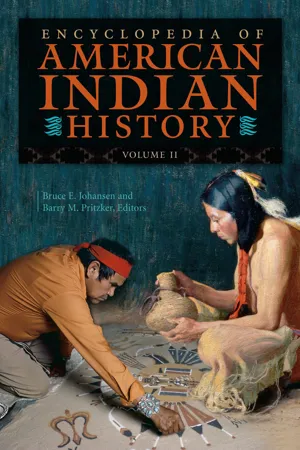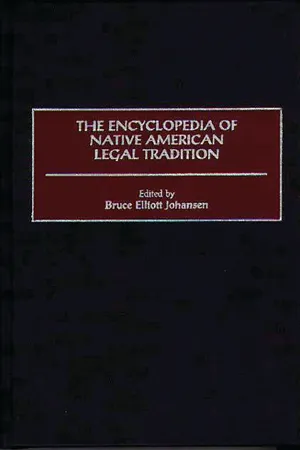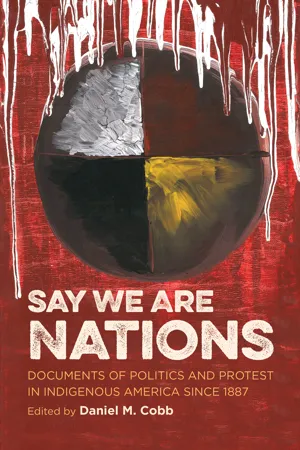History
National Indian Youth Council
The National Indian Youth Council (NIYC) was a Native American civil rights organization founded in 1961. It aimed to promote the rights of Native American youth and to challenge the US government's policies towards Native Americans. The NIYC played a significant role in the Red Power movement of the 1960s and 1970s.
Written by Perlego with AI-assistance
Related key terms
1 of 5
3 Key excerpts on "National Indian Youth Council"
- eBook - PDF
Encyclopedia of American Indian History
[4 volumes]
- Bruce E. Johansen, Barry M. Pritzker, Bruce E. Johansen, Barry M. Pritzker(Authors)
- 2007(Publication Date)
- ABC-CLIO(Publisher)
The National Congress of American Indians: The Founding Years. Lincoln: University of Nebraska Press. Healey, Joseph F. 2005. Race, Ethnicity, Gender, and Class: The Sociology of Group Conflict and Change. Thousand Oaks, CA: Pine Forge Press. Hoxie, Frederick E. 1996. Encyclopedia of North American Indians: Native American History, Culture, and Life from Paleo-Indians to the Present. Boston: Houghton-Mifflin. National Indian Youth Council The National Indian Youth Council (NIYC) is the second-oldest national Indian organization in the United States. (The oldest is the National Congress of American Indians.) Since the termination era dur- ing the 1950s, the NIYC has fought oppressive gov- ernment policies. From the mid-1960s through the early 1970s, the NIYC primarily accomplished its aims through Northwest fish-ins, Red Power protest, and Indian nationalism. While its activities since then have made headlines less often, the NIYC con- tinues its battles through long-term projects such as political research, antidiscrimination lawsuits, and employment services benefiting various indigenous communities. Frequently at the forefront of Indian affairs, the NIYC has promoted self-determination and sovereignty and helped create a new generation of Indian leaders. The NIYC traces its roots to Indian youth coun- cils and college student workshops of the late 1950s. The Southwestern Regional Indian Youth Council, originated by Kiva Club students at the University of New Mexico, provided leadership training for founders of the NIYC. Herbert Blatchford (Navajo), Melvin Thom (Walker River Paiute), and Clyde Warrior (Ponca) were among the hundreds of Indian college students from nearly twenty states 798 National Indian Youth Council who attended these youth councils and participated in debates over termination and other government policies. - Bruce E. Johansen(Author)
- 1998(Publication Date)
- Greenwood(Publisher)
‘‘We believe that examination should be conducted in the first instance in the Tribal Court itself,’’ the Supreme Court ruled. ‘‘Until petitioners have exhausted the remedies available to them in the Tribal Court system … it would be premature for a federal court to consider any relief.’’ This doctrine was refined two years later in Iowa Mutual Insurance Co. v. LaPlante. Legal scholar Frank Pommersheim commented, ‘‘Beneath the geologic holdings of the National Farmers Union and the Iowa Mutual cases, the tectonics of the Page 218 Supreme Court seem to be slowly bringing together the separate continents of federal and tribal courts’’ (1995:95). FURTHER READING Pommersheim, Frank. Braid of Feathers: American Indian Law and Contemporary Tribal Life. Berkeley: University of California Press, 1995. National Indian Youth Council The National Indian Youth Council (NIYC) was one of the first nativerights advocacy groups to grow out of the movement toward Native American self determination that began in the early 1960s. The group, which took major initiatives in treatyrights conflicts, was formed by people who began planning at the 1961 Chicago Indian Conference organized by anthropologist Sol Tax at the behest of President John F. Kennedy. The organizers of NIYC, including John Redhouse, Clyde Warrior, Mel Thom, and Herb Blatchford, broke with older groups such as the National Congress of American Indians, believing them to be too imitative of nonIndian ways. The founders of NIYC, who were from a number of different native nations, brought a coordinated sense of panIndianism to nativerights advocacy. By the middle 1960s, the NIYC was assisting in organization of some of the first ‘‘fishins’’ in the Pacific Northwest, cooperating with a wide spectrum of Indian and minorityadvocacy groups in that area. The efforts of the NIYC in this and other parts of the United States were notable for their multiethnic quality.- eBook - ePub
Say We Are Nations
Documents of Politics and Protest in Indigenous America since 1887
- Daniel M. Cobb(Author)
- 2015(Publication Date)
- The University of North Carolina Press(Publisher)
Disgrace against the Indian in his own home and community is intolerable. It is inconsistent with American Ideals. The perpetual threat that his treaties will be disregarded and his community broken apart is eroding the Indian character and sapping his very life blood. These indignities must be wiped away and the Indian, like any other American, must be able to lead a decent life in a free community.FAITH IN AMERICANS
The NIYC knows that all well-meaning Americans want to act morally and decently in regard to American Indians. NIYC feels that once the American taxpayer realizes the current situation of the American Indians he will no longer allow his tax dollar to be used to continue such a deplorable situation. This is the position of NIYC and their overall attitudes in respect to ameliorating the current situation of Indian communities.With respect to our critics and our views on Indian Affairs the members of National Indian Youth Council state: “We as members of NIYC have to ask ourselves constantly and very clearly which are the things in the past which we mean to carry forward in our children’s life and which are those we shall leave behind.”NIYC is often told we spend too much time talking of the “old days.” But we feel that talking about the past means talking about the future. NIYC has made mistakes. But we were the first to hold our annual meeting in the tradition of our forefathers, the open “council.” Also the first to hold a successful demonstration of protest against abrogation of treaties. Perhaps our mistakes were made in order that they should not be repeated by us and others.Recently a few members of NIYC were talking with a young Indian student who obviously was not a credit to his forefathers. He said “I’m for helping Indians, but I just don’t have time and besides what good will it do me.” We felt sorry for this misguided young soul. He is like many, he wants his future served to him like breakfast in bed on a silver platter, everything to his liking and perfection; then perhaps he may take a bite.
Index pages curate the most relevant extracts from our library of academic textbooks. They’ve been created using an in-house natural language model (NLM), each adding context and meaning to key research topics.


